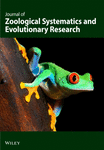Morphological and molecular evidence of the phylogeny of Nereidiform polychaetes (Annelida)
Abstract
The phylogeny of Nereidiformia is assessed in a parsimony analysis of combined morphological and DNA data, with special focus on previously questioned relationships between Chrysopetalidae and Hesionidae, between Pilargidae and Hesionidae, and the affinities of Hesionides and Microphthalmus. A 660 bp segment of the mtDNA cytochrome c oxidase subunit I gene was sequenced for two chrysopetalids, one nereidid, one pilargid, one pisionid, two hesionids, plus the two questionable hesionids Hesionides arenaria and Microphthalmus sp. Phylogenetic resolution was poor for the cytochrome c oxidase subunit I gene data alone, but the combined analysis yielded partially robust topologies, suggesting that nereids are the sister group to chrysopetalids, and that pilargids, Hesionides and Microphthalmus do not belong within the hesionids




